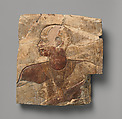Relief attributed to Petamenophis
Late Period, Kushite-early Saite
The sunk relief depicts the large figure of a man with short-cropped hair. He wears a sash across his chest, a broad collar and a large amulet. The sash denotes a lector priest who reads hymns and spells during rituals.
The relief is close to one in Brussels that originated in the tomb of Petamenophis at Thebes and the sash accords with one of the individual's titles as Chief Lector Priest, so that the relief has therefore usually been attributed to him. There are differences, however: despite the similarities in dress and appearance, the treatment of the head shape is different, and the misplaced fragment in the face of this relief (a repair that seems to date before 1919) makes it difficult to compare the profiles. Moreover, the sash of a lector priest is hardly restricted to Petamenophis. At any rate, the relief certainly fits the style of the Kushite Period at Thebes, but until it can be compared with other representations in the tomb of Petamenophis and other Kushite and early Saite monuments at Thebes that are currently being excavated, it's origin cannot be stated as a fact.
Petamenophis, known through many impressive statues, also built a vast tomb (no. 33) on the West Bank at Thebes, larger than the tombs in the Valley of Kings and certainly one of the largest ever built in Egypt. The tomb was open until about 1900, and rightly famed for its extent, but was then closed by the antiquities officials for the next hundred years because of impossible working conditions in the tomb. Meanwhile, Petamenophis himself remained rather mysterious - despite his rich monuments, he did not seem to have any political titles and he never apparently named the king he served.
In 2005 a mission reopened and begin to study the tomb. The investigations have revealed that the tomb incorporates elaborate apartments that model different historical aspects of Egyptian afterlife provisions, and on its walls are a veritable library of religious spells. More information about Petamenophis's titles has emerged: he was 'master of secrets of the two crowns,' and other titles also imply great knowledge and learning about essential ritual. His own background is illuminated to an extent by information about his mother and wife and many maternal relatives. The likelihood that he himself was a Kushite is supported by the absence of citation of paternal relatives, since matrilineal and avuncular lineages are particularly significant in that culture.
Due to rights restrictions, this image cannot be enlarged, viewed at full screen, or downloaded.

